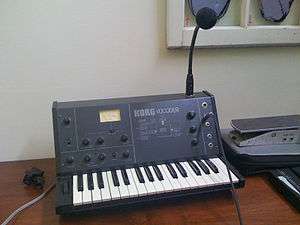Korg VC-10
The Korg VC-10 is an analogue vocoder launched in 1978. Vocoding refers to voice encoding of speech and singing with musical synthesis. It gained popularity in the 1970s following utilisation by bands such as Kraftwerk and Electric Light Orchestra. The VC-10 allows basic functionality in operation and modulation of signal carriers. It has two microphone input options.

Features
The VC-10 "achieved a measure of popularity because it was simple to use, relatively inexpensive and completely self-contained."[1] It features 20-channel polyphony, ensemble mode with speed and depth controls (akin to a chorus function), accent bend control (adds a slight pitch wavering effect so that the sound produced is more like a human voice), octave-up control (extends the range of the keyboard), and tune control as well as various settings relating to input and output mix.
The VC-10 allows for an input from an external signal carrier, such as an electric guitar, to be modulated by the keyboard. It also features an external pitch control input.[2]
Microphone input options
The unit was originally supplied with a gooseneck microphone (the Korg MC-01) which plugged into a bespoke BTS connector. This type of connector is now obsolete. It appears to have originated around 1965 and was phased out when XLR became the standard in later years. It is difficult to source a microphone that will connect to it but TOA Japan [3] still (as of Jan 2015, at a cost of approx. £100) makes a compatible model, the DM-524B. The VC-10 also has a front panel standard microphone phono input jack.
Front panel error
It has been noted on Korg Kornucopia mailing lists [4] that early versions of the VC-10 have a misprint on the front panel block diagram, which spells "FREQUENCY RESPONCE SIMULATOR" rather than the correct "FREQUENCY RESPONSE SIMULATOR".
Notable users in popular music
The Korg VC-10 has been featured in popular music, with notable users including:
| Musician | More info | Reference |
|---|---|---|
| Keith Emerson | — | [5] |
| Roger Waters | (used in Animals) "Floyd first used a Vocoder in Animals (recording during 1976) for Roger’s lead vocals in “Pigs” and for the bastardised psalm on “Sheep”, as well as for the treated barking sounds and other effects in “Dogs”. Rick’s keyboards were also fed through the Vocoder, notably during the middle section of “Dogs”. Although it is not documented which particular model was used in Britannia Row studios for the recording of Animals, it is reported that they used the "now-classic Korg VC-10 model" | [6] |
| Apollo 440 | Listed in Apollo control gear in Sound on Sound article | [7] |
| Klaus Schulze | Documented in 1977/1978 he used Korg as well as Sennheiser vocoders | [8] |
| Isao Tomita | Used on 'The Bermuda Triangle' (1979) on the track 'Vocoder' | [9] |
| Joe Zawinul | Documented to use VC-10 in Sound on Sound article. | [10] |
| The Stranglers | Used on meninblack album around the 1980s | [11] |
External links
References
- ↑ John Shepherd (27 February 2003). Continuum encyclopedia of popular music of the world: VolumeII: Performance and production. Continuum International Publishing Group. p. 268. ISBN 978-0-8264-6322-7. Retrieved 26 January 2011.
- ↑ Analog Vocoder info : VC-10 Accessed 26 01 2011
- ↑ http://www.toa.jp/products/wired_microphones/desktop_microphones/dm-524b.html
- ↑ http://korganalogue.net/
- ↑ Keith Emersons keyboard clearout
- ↑ Richard Wright and Pink Floyd : Keyboard, Synthesizer and electronics equipment
- ↑ APOLLO FOUR FORTY: Ad Astra |accessed 27.01.2011
- ↑ Klaus Schulze's Instruments
- ↑ Bermuda Triangle Recordings
- ↑ Joe Zawinul: Jazz Keyboardist| accessed 27.01.11
- ↑ Mark Jenkins (2 August 2007). Analog synthesizers: understanding, performing, buying: from the legacy of Moog to software synthesis. Elsevier. pp. 150–. ISBN 978-0-240-52072-8. Retrieved 1 January 2006.
- ↑ Official 1978 VC-10 demo recording
- ↑ VC-10 and MC-01 microphone owners manuals